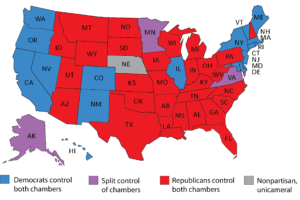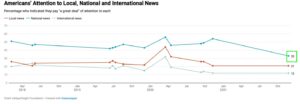E. J. Dionne, Jr.s “Why racism is bad for White people” at The Washington Post provides some useful strategy analysis for Democratic campaigns: “Racism is bad for all of us, White people included….Racism is immoral and has, again and again, led to deadly violence toward our fellow human beings. It is also a dysfunctional force in our polity. It has been used to divide those who should be allies. It casts politics as a zero-sum struggle. It blocks us from seizing shared opportunities. Racism advantages demagoguery over thoughtfulness and hostility over empathy….Perhaps because the term is thrown around so freely, I’d insist that those who condemn racism should not be accused of “virtue signaling.” I’m not fond of the phrase because, in principle, advancing virtue is an absolute necessity in a democratic republic. The idea that free societies depend on public and private virtue is no less true for being ancient — and condemning racism is always the right thing to do….Nonetheless, the popular meaning of the term speaks to an understandable impatience with those who appear to be casting themselves as morally superior and flaunting a more elevated consciousness….Those who would defeat racism need to promote the urgency of solidarity across racial lines without conveying self-satisfied arrogance. In particular, othering White working-class Americans as an undifferentiated mass of unenlightened souls is about the worst strategy imaginable for promoting greater harmony….White working-class racism exists and needs to be confronted. But as a moral matter, White working-class grievances created by economic injustice deserve a response. As a practical matter, the imperatives of coalition politics in a diverse nation require advocates of equal rights and social justice to build alliances across the lines of race that include all Americans facing forms of marginalization….This is why I appreciated Heather McGhee’s argument in her important book “The Sum of Us,” summarized in its subtitle: “What Racism Costs Everyone and How We Can Prosper Together.” Zero-sum thinking, she wrote, “has always optimally benefited only the few while limiting the potential of the rest of us, and therefore the whole.”….As McGhee told Vox’s Sean Illing, “The zero-sum story is the idea that there’s this massive dividing line between Black people and white people, that they’re on opposite teams, and that progress for people of color has to come at white people’s expense.”…Fighting this idea is central to overcoming racism. The possibility of shared advancement helps explain the finding of political scientists Paul Frymer and Jacob M. Grumbach that “white union members have lower racial resentment and greater support for policies that benefit African Americans.”…Unions, they note, need to recruit diverse memberships and are in the business of selling and realizing the idea that workers, no matter their backgrounds, can move forward together. It’s no accident that provoking ethnic and racial division has long been an instrument in the toolbox of union busting.”
Adam Wollner notes at CNN Politics that tomorrow, ” five states will hold primary elections. But it’s Georgia that will be at the center of the spotlight, hosting high-profile races up and down the ballot…. “710,137: That’s how many people have voted early in the state through Thursday, which is a record, according to the Georgia secretary of state’s office. It marks a 180% increase from the same point in the early voting period in 2018 and a 149% increase compared to 2020. Early voting in Georgia ends Friday.”….Manu Raju and Alex Rodgers explain “How Herschel Walker united the right and has Democrats plotting for a fight,” also at CNN Politics: “Walker has had a cakewalk of a primary, skipping a handful of debates or forums, avoiding getting pinned down on policy positions and mostly limiting press appearances to the safe spaces of conservative media. In mid-May, a Fox News poll showed Walker with 66% support from Georgia Republican primary voters — unchanged since March….But after his expected blowout victory in Tuesday’s primary, the scrutiny is only bound to intensify. Democrats are privately planning an aggressive campaign spotlighting Walker’s vulnerabilities, business record, policy views and dirty laundry about the candidate’s past, including his violent behavior with his ex-wife, according to a source familiar with the matter….Walker has said he has dissociative identity disorder, which was previously known as multiple personality disorder, and has sought to advise people with mental health problems….” In “The high-stakes Georgia primaries, by the numbers,…In 2008, his ex-wife claimed that he threatened her life, pointing a gun to her head a handful of times and a straight razor to her throat; Walker said in an interview that year that he didn’t remember being violent toward her, but he didn’t deny it and noted that one of the symptoms of his disorder was blackouts….In 2012, an ex-girlfriend told authorities that Walker had also threatened to kill her and “blow her head off” and then “blow his head off.” After the allegation was reported last year, Walker’s spokesman said the candidate “emphatically denies these false claims.”…And a third woman also said Walker threatened and stalked her in 2002. Walker’s campaign previously declined to respond to the woman’s allegations or discuss the police report….Top Democrats believe that Walker will collapse as the fight between freshman Democratic Sen. Raphael Warnock and Walker intensifies.”
From “Is the center shrinking in the Democratic primaries? Democratic voters are moving their party to the left — and dragging candidates with them” by Christian Paz at Vox: “This year’s Democratic primaries are being largely framed as an ideological struggle between the national party’s moderate and progressive wings. But voting patterns over the last few weeks have complicated that narrative….In marquee contests in Pennsylvania and Oregon, progressive wins led to proclamations that the left wing of the party is gaining influence, while some moderate victories defied that thinking. What’s becoming clear as votes are counted, however, is that Democratic primary voters seem to care less about who the “progressive candidate” is and more about if candidates are campaigning on progressive goals. What many of the Democrats who won this week have in common is that they all embraced progressive priorities tailored to where they were running….Perhaps nowhere encapsulated this reality better than swing-state Pennsylvania, where a relatively progressive and locally trusted candidate who repeatedly rejected the progressive label — Lt. Gov. John Fetterman — trounced the more moderate, Washington favorite, Rep. Conor Lamb, in the primary race for the US Senate….Around the state, candidates who delivered digestible versions of progressive messages did well, from the left-leaning candidates who won races in heavily Democratic areas for state and federal legislatures to the moderate incumbents who survived tough challenges from the left. In nearly all of these races, a general shift to the left was apparent among the party’s base and candidates….This trend isn’t necessarily universal: Plenty of more traditional moderate Democrats won their races in Ohio and North Carolina. And it’s possible upcoming races in California, Illinois, Michigan, and Texas may upset this narrative. But for the most part, the primaries so far appear to show that progressive activism and ideas have changed what primary voters want and what their candidates are offering….What does tie a lot of Tuesday’s races together, though, is how few moderates ran openly down the middle of the ideological spectrum without co-opting at least some of the issues and language progressives have used in previous races. That includes things like advocating for a higher minimum wage, expanding health care access and coverage, more openly embracing gun control and abortion rights, and at least addressing climate change….The general election may in turn change the way these candidates talk about their priorities. The citizens who typically turn out to vote in November tend to be less ideological and party-affiliated than the voters who participate in primary elections. And the progressive ideals beloved by hardcore Democrats may not be as well received by moderates and centrists in competitive general election seats….If progressives — and progressive ideas — do win uphill battles in these swing districts, however, Democrats may end up with a newly empowered left flank, catalyzing the political polarization Americans have come to expect from their government.”
At Daily Kos, check out “” by Ian Reifowitz.” Reifowitz, author of “The Tribalization of Politics: How Rush Limbaugh’s Race-Baiting Rhetoric on the Obama Presidency Paved the Way for Trump ,” writes: “What else do working-class voters who are gettable for Democrats have to say on the specific question of how progressives can win their votes? After conducting a survey specifically of these voters (those surveyed did not have a four-year college degree, and did not identify as Republicans), Jacobin, YouGov, and the Center for Working-Class Politics presented the answers these voters provided:
- Focus on “bread-and-butter economic issues (jobs, health care, the economy)” framed in “plainspoken, universal terms.” This was especially important in rural/small-town regions.
- Specifically name “elites as a major cause of America’s problems” and “celebrate the working class.”
- Don’t “surrender questions of social justice to win working-class voters,” but refrain from using “highly specialized, identity-focused language” to express those positions. The full report gave examples of these kinds of terms, as tested in the survey: “systemic injustice,” “cultural appropriation,” “equity,” “Latinx,” and “BIPOC.” This language garnered less support than other Democratic messages. This disparity in terms of support was especially acute among blue-collar as opposed to white-collar working-class voters.
The authors added that working-class voters also responded much more positively overall to working-class candidates than wealthier ones, whereas a candidate’s race and gender were not a factor. Finally, the surveys indicated that few “low-propensity voters” decide to not vote because candidates aren’t progressive enough….Maybe altering the messaging—along with other crucial steps like remaining consistently engaged with marginalized communities, not just in election season—to address this gap will help campaigns pick up a point, or two, or three overall in this fall’s races. And maybe that would be enough to move a dozen—hey, we’ll take even a handful—of House races from the red column to the blue. Or to flip the result of U.S. Senate races in Pennsylvania, North Carolina, Georgia, Wisconsin, or Nevada. Turning even a small number of losses into victories could make the difference in control of one or both houses of Congress. The same goes for state legislatures and races for governor.”










